Verdict
Herschel’s big, freestanding infrared heater looks modern and distinctive, and fills even medium-sized rooms with a subtle but effective heat. Its touch-sensitive controls are quite easy to use, while its app adds more sophisticated features like programming and a holiday mode. While it doesn’t make everything in a room feel toasty, it heats the people in it using much less electricity. That could be great for the environment and your wallet – but only if the latter can get past a £600 asking price.
Pros
- Smart controls
- Great build quality and warranty
- Low energy use
Cons
- Inaccurate thermostat
- Very expensive to buy
- No tip-over protection
-
A powerful infrared heaterThis 1,000-watt monolith is about as powerful as domestic infrared heaters get. It directly heats the people in a room, rather than the air, so it’s much more efficient than a conventional heater. -
Smart controlsThis heater’s onboard control panel is fairly minimal, but you can use the Smart Life app to configure a good range of energy saving and convenience options.
Introduction
Herschel makes a wide range of infrared panel heaters in its UK factory, but I’ve chosen to review its rather unusual-looking Select S3 freestanding heater.
A white monolith standing just over a metre tall, it doesn’t look like a typical flat-panel infrared device and it’s completely different to conventional convection heaters. Its four sides are largely featureless, and there are no obvious controls. From the front it looks much like a high-end speaker cabinet without the speakers.
This heater is designed for portable use in homes and offices. Its unusual design allows it to beam out heat from three sides, meaning you could place it centrally and have it cover a reasonably large space – Herschel says it’ll heat rooms up to 15 square metres. The Select S3’s thousand-watt output is comparatively big for an infrared heater, making this more suited to medium rooms and living spaces than, say, a small bedroom. But because infrared heating depends largely on a line of sight to the heater, it’s probably not ideal in cluttered rooms or those with lots of furniture.
This heater is IP44 rated against dust and water, which means you can use it within zone 2 in a bathroom – outside the splash zones of any baths, sinks or showers. It also comes with an impressive five-year warranty.
Design and features
- Smart design
- Basic on-device controls
- More comprehensive options through app
As with most heaters, life with the Select S3 begins by bolting its feet on. In this case, that’s a sturdy square metal stand with a slightly wider footprint than the heater itself. At 16 kilos, the S3 is moderately heavy. It’s also big, and it can be a little tricky to manoeuvre despite the chunky handle included near its base. I managed to clunk the wall a couple of times going up and down my winding staircase.
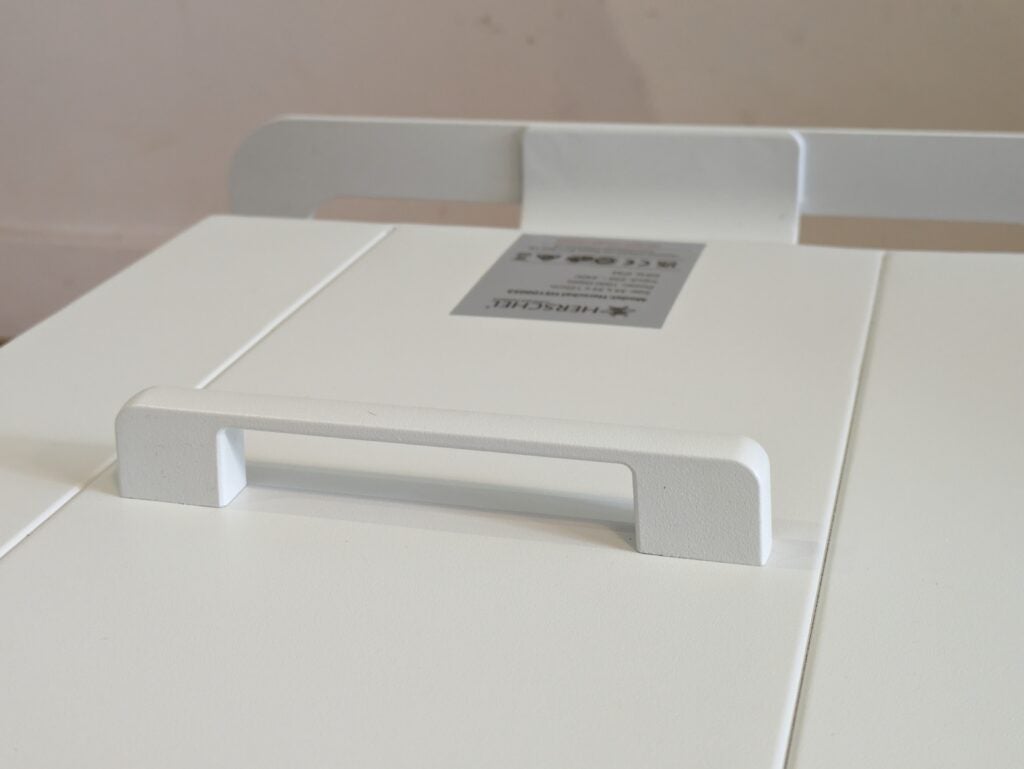
Plug in the Select S3 and a set of touch-sensitive controls appear under the glass panel sitting on its top surface. These are fairly basic, covering only power, temperature and a 24-hour off timer, but you can access everything else through the Smart Life app. After a few seconds of inactivity the top panel controls will go out again, so the otherwise featureless heater will continue to mystify visitors.
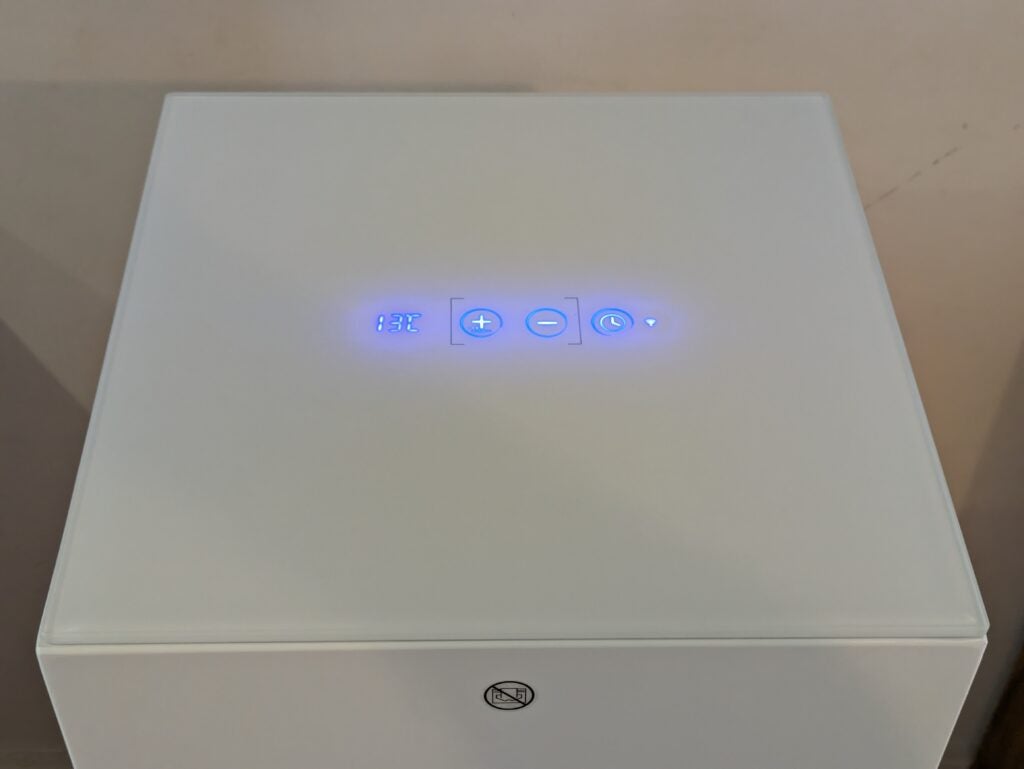
I found it easy to add the Herschel S3 in its app, which in Manual mode supports the same simple temperature setting and off timer you’ll find on the device itself. You can also set a schedule, which – slightly oddly – is preconfigured with four periods: wake, leave, return and sleep. These can be edited with different times and temperatures for each day of the week, so they should cover most use scenarios, but you can’t rename them.
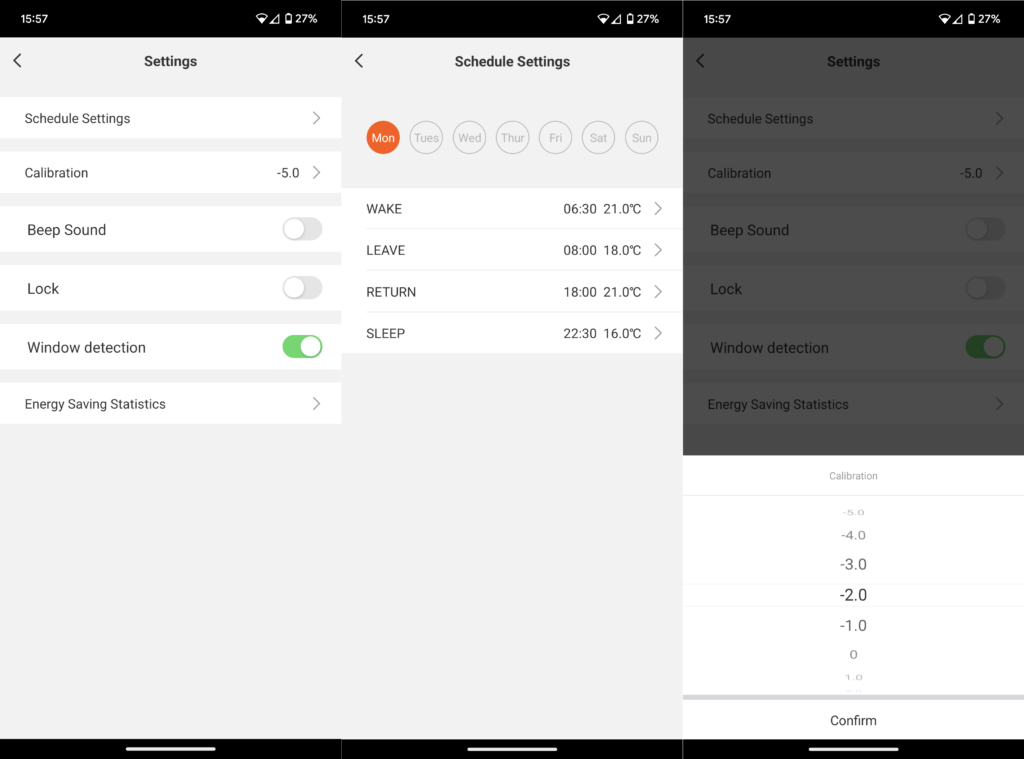
This heater’s holiday mode will keep it switched off for up to 99 days, should you be lucky enough to be away that long. There’s also open window detection, a child lock, and a calibration feature to correct the readings from its onboard thermostat. The final options are to turn off the key beep, and view your energy savings when compared to a regular heater.
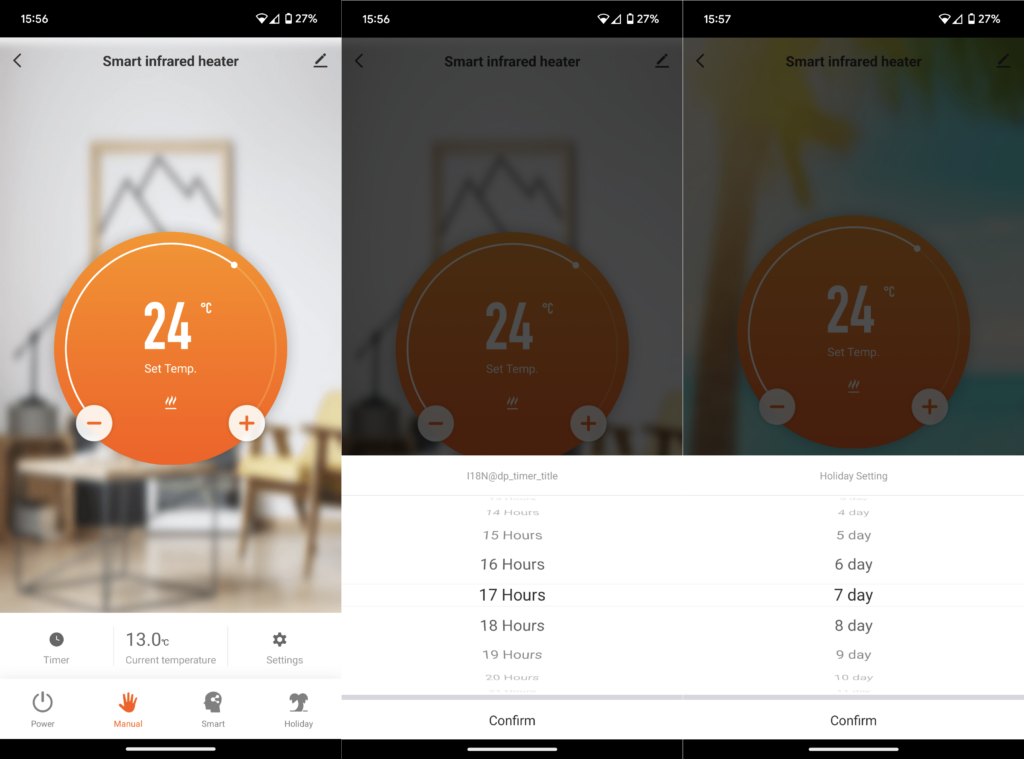
Like other infrared heaters, the Herschel Select S3 heats by radiating infrared light into the room. This warms up the people, surfaces and other things it lands on, but doesn’t directly heat the air That’s a big difference to convection electric heaters, which heat the air. While a convection heater raises the temperature of the whole room, infrared heaters make less direct difference; the heat absorbed by walls and furniture can reflect back into the room, but it’s not as direct a process.
The main difference is that rather than trying to heat an entire room, infrared heaters work like the sun, making people in the room feel warmer, regardless of the ambient temperature. That is, provided that there’s nothing blocking the infrared light from reaching them.
This tall heater’s sturdy feet mean it’s not as easy to knock over as you’d expect, but I was surprised to find it doesn’t come with tip-over protection.
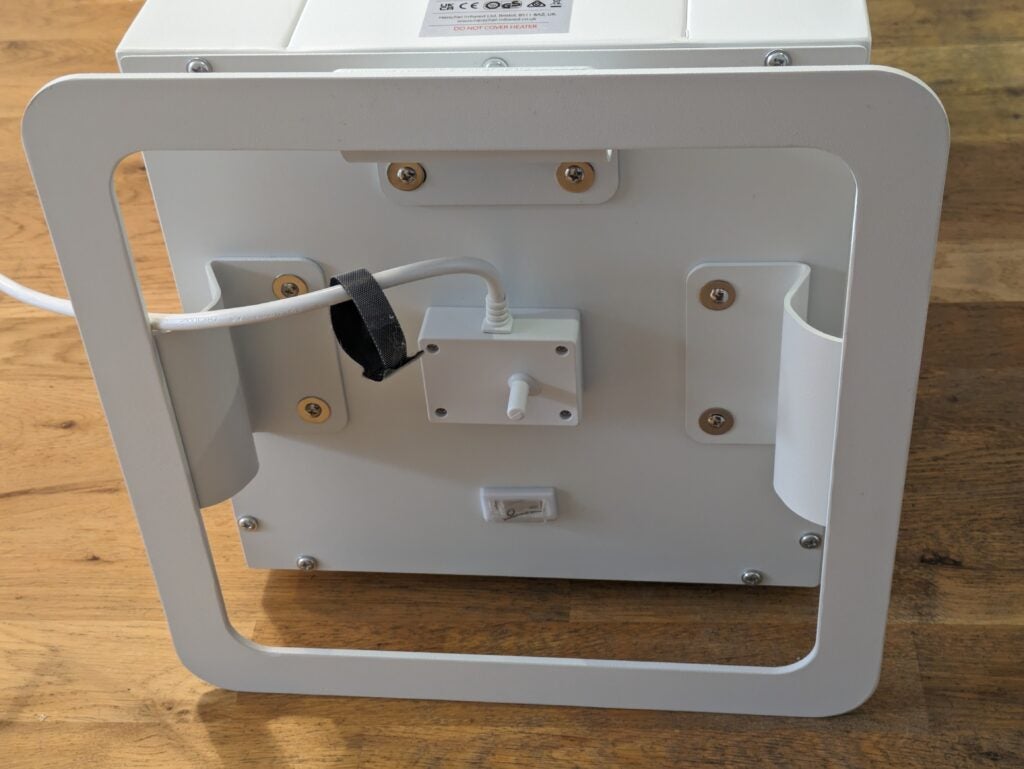
Performance
- Surprisingly effective heating
- Inaccurate thermostat
- Likely to cost less to run than conventional heaters
This is the most powerful infrared heater I’ve tested, but its heating effect is still quite subtle. Up close you’ll feel it begin to warm up after only a few seconds, but from a couple of metres away the heat is barely noticeable – it’s certainly not like being hit in the face by a beam of sunlight. That doesn’t mean it’s ineffective, however, and anyone in the room will begin to notice themselves warming up over time.
In use, I measured a power demand of 1014W, which is about a third of the most powerful domestic convection heaters. But despite heating primarily through infrared light, the Select S3 also gets surprisingly warm. After 30 minutes, the centre of its four vertical sides was too hot to touch. This surface heating also means that the Select S3 does raise the temperature of the air in a room slightly, although possibly not as much as you’d experience with a 1kW convection heater.
I tested the Select S3 on a bitterly cold January day in a mid-sized room that had cooled to just 14.4°C overnight. After 30 minutes it had raised the air temperature in the centre of the room to 15.3°C, and after an hour this hit 16.4°C – directly comparable with my results from the Duux Edge 1000, a 1,000-watt convection heater I tested in similar conditions. However, while the Edge nudged my smart radiator thermostat up by 1.4°C over one hour, the Herschel Select S3 raised it by only 0.5°C.
That said, an infrared heater isn’t designed to warm the room in the same way, so monitoring air temperature isn’t directly comparable; infrared is designed for heating people and objects directly. In that regard, the Select S3 made the room comfortable, even if the ambient temperature reading showed the air temperature as being relatively cool.
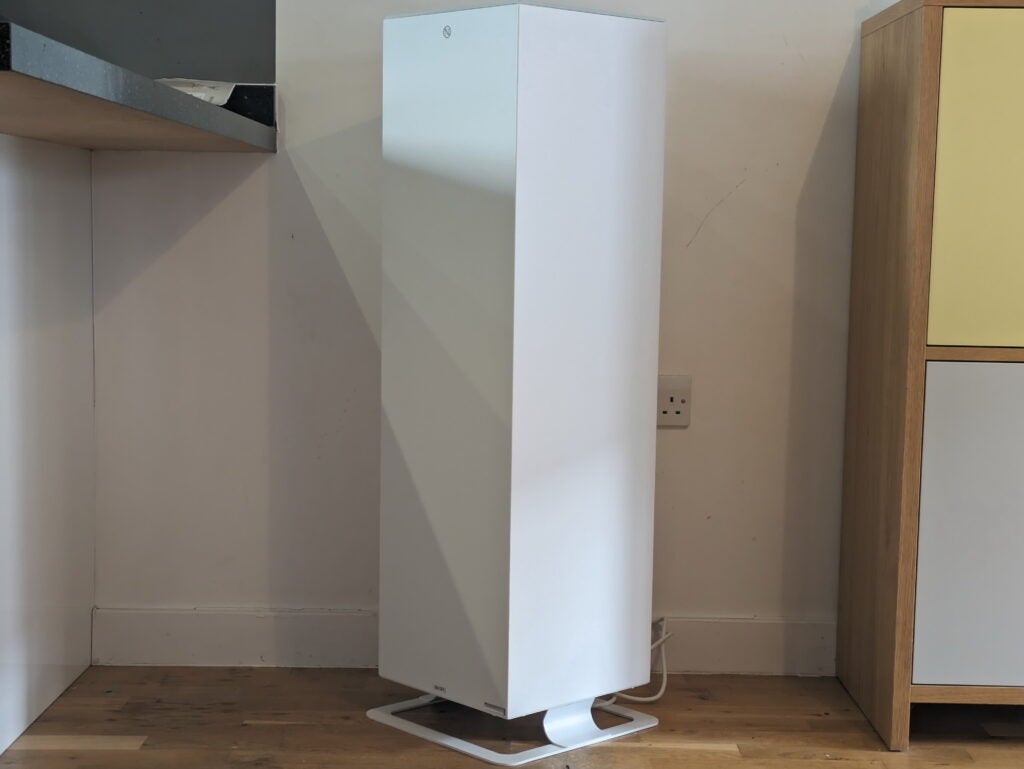
While my room and radiator thermostat recorded only modest temperature gains, the Select S3 itself was wildly optimistic, recording a balmy 28°C after an hour’s use. Even using the maximum five-degree correction available through the app, it still overestimated the room temperature by about 6°C. Conversely, when cold it tended to be reasonably accurate, so my five-degree correction had the effect of making it under-report the room temperature.
This made it hard to find an appropriate setting. For my initial test I cranked the target temperature up to the maximum 37°C so the heater ran constantly. This helped me to stay toasty, but it also meant the Select S3 never switched off. Used in this way I measured consumption of 1.04 kilowatt hours (kWh) per hour, which isn’t any less than I’d expect from a small convection heater.
With a bit more experimentation, I found that the maximum -5°C temperature correction worked well when combined with a slightly higher than normal target temperature of 24°C. This caused the Herschel Select S3 Freestanding Heater to cycle on and off in a room already heated to 20°C, reducing its power consumption to about 0.4kWh over an hour. That’s a bit less than I’d expect from a convection heater running in similar circumstances. Ultimately, with infrared heating, it does take some time to find the right setting that feels comfortable.
Latest deals
Should you buy it?
You want to heat a large space
Warming people and objects directly, this heater is a good choice for those that want to feel warm in a large room but don’t want the running cost of a traditional electric heater.
You need a more compact option
This is a large and expensive heater, and it needs an unobstructed space to work in effectively, which may make it hard to position in a crowded room.
Final Thoughts
I like the design of the Herschel Select S3, and it feels extremely well made. The longer I spent with it, the more I appreciated its warming effect. Because it doesn’t rely on heating the air to warm you up, I could also feel the benefit quite quickly in a very cold room.
My tests show that, like other infrared heaters, the Select S3 could save you money compared to a regular convection heater. However, it is expensive and bulky, and needs an unobstructed space to work properly. Unlike panel IR heaters, this one can’t be ceiling mounted, so it needs a considerable amount of space to work. If you need something smaller, the guide to the best electric heaters can help.
How we test
Unlike other sites, we test every heater we review thoroughly over an extended period of time. We use industry standard tests to compare features properly. We’ll always tell you what we find. We never, ever, accept money to review a product.
Find out more about how we test in our ethics policy.
Used as our main heater for the review period
We measure the fan speed (if available) using an anemometer so that we can accurately compare performance between models
We measure the heat output of the fan and its effect on our test lab.
FAQs
Infrared panels heat you, rather than the room, so they start warming you up almost as soon as you turn them on. On the flip side, you’ll start cooling down as soon as they’re off. They also don’t heat the fabric of a room in the same way as convector heaters and central heating, so you may still be left with cold spots.
Infrared panels typically have a lower power rating than other electric heaters, so they use less power when operating. However, convector and fan heaters with a thermostat don’t spend all their time actively heating, so in practice they may not consume that much more. At January 2024 energy prices, gas central heating is for most people the cheapest way to heat a house.
Verdict
Herschel’s big, freestanding infrared heater looks modern and distinctive, and fills even medium-sized rooms with a subtle but effective heat. Its touch-sensitive controls are quite easy to use, while its app adds more sophisticated features like programming and a holiday mode. While it doesn’t make everything in a room feel toasty, it heats the people in it using much less electricity. That could be great for the environment and your wallet – but only if the latter can get past a £600 asking price.
Pros
- Smart controls
- Great build quality and warranty
- Low energy use
Cons
- Inaccurate thermostat
- Very expensive to buy
- No tip-over protection
-
A powerful infrared heaterThis 1,000-watt monolith is about as powerful as domestic infrared heaters get. It directly heats the people in a room, rather than the air, so it’s much more efficient than a conventional heater. -
Smart controlsThis heater’s onboard control panel is fairly minimal, but you can use the Smart Life app to configure a good range of energy saving and convenience options.
Introduction
Herschel makes a wide range of infrared panel heaters in its UK factory, but I’ve chosen to review its rather unusual-looking Select S3 freestanding heater.
A white monolith standing just over a metre tall, it doesn’t look like a typical flat-panel infrared device and it’s completely different to conventional convection heaters. Its four sides are largely featureless, and there are no obvious controls. From the front it looks much like a high-end speaker cabinet without the speakers.
This heater is designed for portable use in homes and offices. Its unusual design allows it to beam out heat from three sides, meaning you could place it centrally and have it cover a reasonably large space – Herschel says it’ll heat rooms up to 15 square metres. The Select S3’s thousand-watt output is comparatively big for an infrared heater, making this more suited to medium rooms and living spaces than, say, a small bedroom. But because infrared heating depends largely on a line of sight to the heater, it’s probably not ideal in cluttered rooms or those with lots of furniture.
This heater is IP44 rated against dust and water, which means you can use it within zone 2 in a bathroom – outside the splash zones of any baths, sinks or showers. It also comes with an impressive five-year warranty.
Design and features
- Smart design
- Basic on-device controls
- More comprehensive options through app
As with most heaters, life with the Select S3 begins by bolting its feet on. In this case, that’s a sturdy square metal stand with a slightly wider footprint than the heater itself. At 16 kilos, the S3 is moderately heavy. It’s also big, and it can be a little tricky to manoeuvre despite the chunky handle included near its base. I managed to clunk the wall a couple of times going up and down my winding staircase.

Plug in the Select S3 and a set of touch-sensitive controls appear under the glass panel sitting on its top surface. These are fairly basic, covering only power, temperature and a 24-hour off timer, but you can access everything else through the Smart Life app. After a few seconds of inactivity the top panel controls will go out again, so the otherwise featureless heater will continue to mystify visitors.

I found it easy to add the Herschel S3 in its app, which in Manual mode supports the same simple temperature setting and off timer you’ll find on the device itself. You can also set a schedule, which – slightly oddly – is preconfigured with four periods: wake, leave, return and sleep. These can be edited with different times and temperatures for each day of the week, so they should cover most use scenarios, but you can’t rename them.

This heater’s holiday mode will keep it switched off for up to 99 days, should you be lucky enough to be away that long. There’s also open window detection, a child lock, and a calibration feature to correct the readings from its onboard thermostat. The final options are to turn off the key beep, and view your energy savings when compared to a regular heater.

Like other infrared heaters, the Herschel Select S3 heats by radiating infrared light into the room. This warms up the people, surfaces and other things it lands on, but doesn’t directly heat the air That’s a big difference to convection electric heaters, which heat the air. While a convection heater raises the temperature of the whole room, infrared heaters make less direct difference; the heat absorbed by walls and furniture can reflect back into the room, but it’s not as direct a process.
The main difference is that rather than trying to heat an entire room, infrared heaters work like the sun, making people in the room feel warmer, regardless of the ambient temperature. That is, provided that there’s nothing blocking the infrared light from reaching them.
This tall heater’s sturdy feet mean it’s not as easy to knock over as you’d expect, but I was surprised to find it doesn’t come with tip-over protection.

Performance
- Surprisingly effective heating
- Inaccurate thermostat
- Likely to cost less to run than conventional heaters
This is the most powerful infrared heater I’ve tested, but its heating effect is still quite subtle. Up close you’ll feel it begin to warm up after only a few seconds, but from a couple of metres away the heat is barely noticeable – it’s certainly not like being hit in the face by a beam of sunlight. That doesn’t mean it’s ineffective, however, and anyone in the room will begin to notice themselves warming up over time.
In use, I measured a power demand of 1014W, which is about a third of the most powerful domestic convection heaters. But despite heating primarily through infrared light, the Select S3 also gets surprisingly warm. After 30 minutes, the centre of its four vertical sides was too hot to touch. This surface heating also means that the Select S3 does raise the temperature of the air in a room slightly, although possibly not as much as you’d experience with a 1kW convection heater.
I tested the Select S3 on a bitterly cold January day in a mid-sized room that had cooled to just 14.4°C overnight. After 30 minutes it had raised the air temperature in the centre of the room to 15.3°C, and after an hour this hit 16.4°C – directly comparable with my results from the Duux Edge 1000, a 1,000-watt convection heater I tested in similar conditions. However, while the Edge nudged my smart radiator thermostat up by 1.4°C over one hour, the Herschel Select S3 raised it by only 0.5°C.
That said, an infrared heater isn’t designed to warm the room in the same way, so monitoring air temperature isn’t directly comparable; infrared is designed for heating people and objects directly. In that regard, the Select S3 made the room comfortable, even if the ambient temperature reading showed the air temperature as being relatively cool.

While my room and radiator thermostat recorded only modest temperature gains, the Select S3 itself was wildly optimistic, recording a balmy 28°C after an hour’s use. Even using the maximum five-degree correction available through the app, it still overestimated the room temperature by about 6°C. Conversely, when cold it tended to be reasonably accurate, so my five-degree correction had the effect of making it under-report the room temperature.
This made it hard to find an appropriate setting. For my initial test I cranked the target temperature up to the maximum 37°C so the heater ran constantly. This helped me to stay toasty, but it also meant the Select S3 never switched off. Used in this way I measured consumption of 1.04 kilowatt hours (kWh) per hour, which isn’t any less than I’d expect from a small convection heater.
With a bit more experimentation, I found that the maximum -5°C temperature correction worked well when combined with a slightly higher than normal target temperature of 24°C. This caused the Herschel Select S3 Freestanding Heater to cycle on and off in a room already heated to 20°C, reducing its power consumption to about 0.4kWh over an hour. That’s a bit less than I’d expect from a convection heater running in similar circumstances. Ultimately, with infrared heating, it does take some time to find the right setting that feels comfortable.
Latest deals
Should you buy it?
You want to heat a large space
Warming people and objects directly, this heater is a good choice for those that want to feel warm in a large room but don’t want the running cost of a traditional electric heater.
You need a more compact option
This is a large and expensive heater, and it needs an unobstructed space to work in effectively, which may make it hard to position in a crowded room.
Final Thoughts
I like the design of the Herschel Select S3, and it feels extremely well made. The longer I spent with it, the more I appreciated its warming effect. Because it doesn’t rely on heating the air to warm you up, I could also feel the benefit quite quickly in a very cold room.
My tests show that, like other infrared heaters, the Select S3 could save you money compared to a regular convection heater. However, it is expensive and bulky, and needs an unobstructed space to work properly. Unlike panel IR heaters, this one can’t be ceiling mounted, so it needs a considerable amount of space to work. If you need something smaller, the guide to the best electric heaters can help.
How we test
Unlike other sites, we test every heater we review thoroughly over an extended period of time. We use industry standard tests to compare features properly. We’ll always tell you what we find. We never, ever, accept money to review a product.
Find out more about how we test in our ethics policy.
Used as our main heater for the review period
We measure the fan speed (if available) using an anemometer so that we can accurately compare performance between models
We measure the heat output of the fan and its effect on our test lab.
FAQs
Infrared panels heat you, rather than the room, so they start warming you up almost as soon as you turn them on. On the flip side, you’ll start cooling down as soon as they’re off. They also don’t heat the fabric of a room in the same way as convector heaters and central heating, so you may still be left with cold spots.
Infrared panels typically have a lower power rating than other electric heaters, so they use less power when operating. However, convector and fan heaters with a thermostat don’t spend all their time actively heating, so in practice they may not consume that much more. At January 2024 energy prices, gas central heating is for most people the cheapest way to heat a house.
























